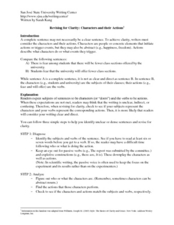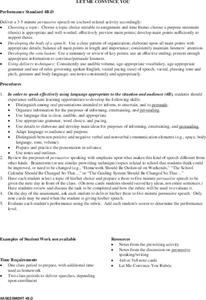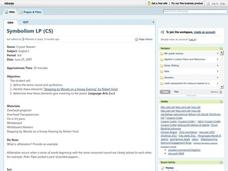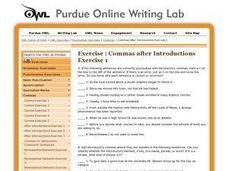San José State University
Revising for Clarity: Characters and Their Actions
This handout offers a three-step process for revising sentences for clarity: diagnose, analyze, revise. After reading an example sentence revision with a detailed explanation, learners complete three sample sentences using the three-step...
Curated OER
Shizuko’s Daughter: Discussion Web
Is Yuki a selfish character? Analyze her motivation and behavior during a unit on Shizuko's Daughter by Kyoko Mori. Readers fill out two sides of a graphic organizer with reasons why or why not she is selfish, and then come up with a...
Teaching English
Fairy Tales; Not Just for Kids
"Once upon a time . . ." Language learners examine the key elements of well-known fairy tales and then craft their own.
Curated OER
Akron: This City Reads
Students write their thoughts about the value of reading and of Akron launching a city wide reading campaign. Students also research literacy in their own community, finding out how it compares to Akron's statistics where it has been...
Curated OER
The Outsiders Journal Guide for Chapter Six
In this novel guide learning exercise, students respond to eleven short answer questions about the plot and literary elements of Chapter Six in The Outsiders.
Curated OER
"A Sound of Thunder" by Ray Bradbury: Questions
These questions are designed to accompany Ray Bradbury's "A Sound of Thunder," and could be used to guide and focus readers or as an assessment of reading skill and knowledge of the elements of a story. Page one focuses on questions of...
Curated OER
Nature - animals in environment
Seventh graders observe and draw animals in their environment. They also examine the work of other artists. They choose one animal and create a clay model of it in its environment.
Curated OER
Understanding Theme with Fables
What is the moral of the story? Ask your class to read a series of fables from which the last line has been removed. After supplying this concluding statement, they must justify their responses. This could be used as an individual or...
Curated OER
Let Me Convince You
Students examine the elements of a persuasive speech and brainstorm topics related to school that they think should be changed. They compose and deliver a three to five minute persuasive speech to their classmates using the key...
Curated OER
SATP Basic Parts of an Informative Essay
Students identify the elements of an informative essay. Through a teacher led discussion, students explore the basic parts of a five paragraph essay and , using a hamburger as an analogy, students label the pieces. They discuss the...
Curated OER
Cinquain
Students create an original Cinquain (five-line poem) and choreograph movement to their poem, performing movement for class and video. This lesson addresses standards in the arts and requires a video recorder.
Curated OER
Information Problem Solving
Middle schoolers review the six steps of conducting research to find out information and to problem solve. This is lesson plan one in a five lesson plan unit.
Curated OER
Symbolism Lesson Plan
Students define the terms symbolism and mood. In groups, they read a poem by Robert Frost and identify the concepts in the poem. As a class, they discuss how the two elements give a meaning to the writing. They also give their own...
Curated OER
What is in the Newspaper?
In this language arts worksheet, students examine the parts of a newspaper by examining a front page format. Students match 5 elements to where they are on the page and answer 5 questions.
Curated OER
Owning a Dog: Reading Comprehension
In this reading comprehension instructional activity, students read the five paragraph essay about the effects of children owning a dog. Then they answer 10 questions to indicate comprehension of the selection.
Curated OER
Compare and Contrast Culture
Fifth graders compare and contrast the cultures of American culture with that of the other cultures of North America. Using traditional and Internet research, 5th graders gather data on one element of culture for comparison. Data...
Curated OER
Comprehension: Setting
Young scholars discuss what setting represents. In this language arts lesson, students review the three elements of setting: where the story takes place, when does the story take place, and is it past, present, or future? Young scholars...
Curated OER
Introduction to Greek Theater and Antigone
Pupils produce a bulleted list of five facts about Greek Theater, complete the comparison graphic of Greek Theater Web sites, and create a bulleted list of four major themes.
Curated OER
Draw Me a Mammal!
Fifth graders illustrate at least three art elements in a drawing of a mammal they've read about with 100% accuracy. As a review, Bloom's Taxonomy questions are asked as they prepare to sketch something they pictured in the story they read.
Curated OER
15 Seconds of Fame
Students write an autobiographical essay. In this writing lesson students read a narrative, Panic in Paris, and review the elements of a narrative as a class discussion. Well-known stories are used as examples for writing their own...
Curated OER
Combating Corrosion
Study corrosion on bronze statues with a hands-on instructional activity. As pupils place a penny in water with salt, they observe the changes in the penny throughout a period of a week. They then analyze the pre-conservation and the...
Curated OER
Commas After Introductions Exercise 2
In this comma usage worksheet, students are given ten sentences that they must correct by placing a commas in the correct place. Students must identify whether there was an introductory word, clause or phrase in the sentence.
Curated OER
Commas After Introductions Exercise 1
In this three part comma usage worksheet, students are first given sentences where they must correct errors in comma usage. Students then go on to punctuate sentences with commas after introductory words and phrases, then they must write...
Curated OER
Multimedia Book Reports
Students read a chapter book of 100-200 pages in length. They create a story map and multimedia book report. Pupils review the elements of a story map such as: characters, setting, problem, important events, solution, etc.) Students...

























